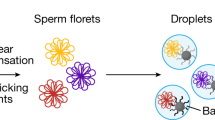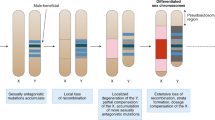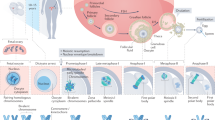Abstract
THE existence of sub-diploid chromosome numbers in the somatic tissues of mammals has for long been a matter of controversy. This had centred around several earlier reports of the normal occurrence of many somatic cells with less than the diploid number of chromosomes. The controversy has again been recently revived by reports1 that the human uterine endometrium normally contains cells with varying numbers, ranging from 4 to 104, of chromosomes. The highest frequency peak of these numbers is supposed to lie in cells with 20–25 chromosomes, with a much lower peak in cells with 45–50 chromosomes. It is also suggested that this type of chromosome variation may be a distinct characteristic of warmblooded animals.
This is a preview of subscription content, access via your institution
Access options
Subscribe to this journal
Receive 51 print issues and online access
$199.00 per year
only $3.90 per issue
Buy this article
- Purchase on Springer Link
- Instant access to full article PDF
Prices may be subject to local taxes which are calculated during checkout
Similar content being viewed by others
References
Timonen, S., and Therman, E., Nature, 166, 995 (1950). Timonen, S., Acta Obstetr. Scand., 31, Supp. 2, 1 (1950). Therman, E., and Timonen, S., Hereditas, 37, 266 (1951).
Sachs, Leo, Heredity, 6, 157 (1952).
Sachs, Leo, Heredity, [7, 227 (1953)].
Sachs, Leo, Heredity, 6, 357 (1952).
Author information
Authors and Affiliations
Rights and permissions
About this article
Cite this article
SACHS, L. Sub-Diploid Chromosome Variation in Man and other Mammals. Nature 172, 205–206 (1953). https://doi.org/10.1038/172205b0
Issue Date:
DOI: https://doi.org/10.1038/172205b0
This article is cited by
-
Karyotypes of Malayan rats (Rodentia-Muridae, genus Rattus Fischer)
Chromosoma (1969)
-
Chromosomal Constitution of Human Endometrium
Nature (1966)
-
The normal karyotype in mice of a highly leukemic AKR strain
Bulletin of Experimental Biology and Medicine (1966)
-
Chromosomal alterations in relation to speciation
The Botanical Review (1959)
-
Aneuploide Chromosomenzahlen in den Mitosen der Leber Verschieden alter Ratten
Chromosoma (1957)
Comments
By submitting a comment you agree to abide by our Terms and Community Guidelines. If you find something abusive or that does not comply with our terms or guidelines please flag it as inappropriate.



